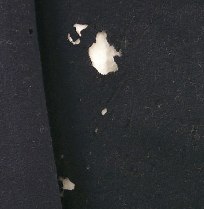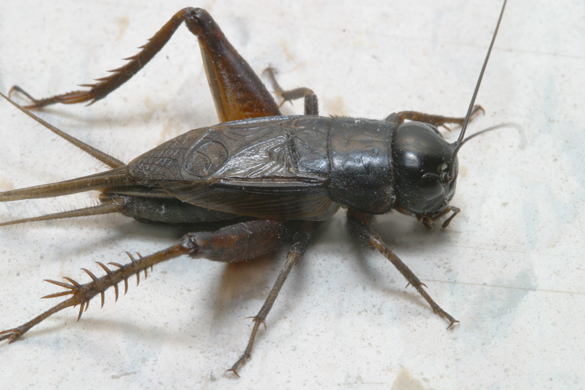Here at Buzz Kill Pest Control, we know that your memories of hot summer nights probably include the sound of crickets chirping from out-of-site locations, like beneath rocks or in tall grass. But as the temperatures grow cooler, their chirps become louder and for good reason—they’re calling out to possible mates. Besides getting louder, they also crave the bright lights of big and little cities. In particular, they are attracted to lights higher in the sky, so should you go to a nighttime football game in the fall, be prepared for a nearly apocalyptic swarm of these critters.
As a pest control company, we can tell you that cricket outbreaks are one of the most probable and predictable pest events of the year in most areas of Texas. During late summer and fall, adult crickets become especially abundant around homes and commercial buildings. Most of the crickets involved in these insect outbursts belong to the Gryllus assimilis complex. Collectively, they are referred to as black field crickets or field crickets.
What Do We Know About These Creepy Critters?
Field cricket eggs are laid in the fall, usually about two weeks after females mature and develop wings. A single female cricket may lay from 150-400 eggs. Eggs remain in the soil throughout the winter and hatch the following spring. Cricket nymphs are identified by the incomplete development of their wings. Adolescent crickets require around three months to complete their development and become adults. Once the cricket reaches the adult stage, it is capable of flight and mating. Cricket outbreaks occur when large numbers of nymphs complete their development and embark on nighttime mating flights.
The reason for cricket outbreaks is not fully understood; however, less fungal disease among eggs and cricket nymphs may provide a partial explanation. Although crickets can be locally abundant in any year, numbers appear to be highest in August and September when a summer drought is broken by rainfall and cooler weather. Just like us, they’re not fond of the heat and are likely to seek out shade. And, like us, they instinctively know that fall is coming. Cool temperatures have caused the crickets to swarm, kicking off their mating season. This insect invasion has homes and businesses contending with the frisky insects in the daytime and anyplace with bright lights at night. Keep in mind, this is just one of the first infestations of the fall. Experts say the unusually wet summer means the crickets won’t be going anywhere for weeks.
What Kind of Havoc Do They Wreak?
 Field crickets are primarily outdoor insects, which means that they are only inadvertent indoor invaders. Nevertheless, in abundance, they can become a considerable household irritation. Unlike house crickets, which are the type of crickets sold in pet stores for food, field crickets do not breed indoors or establish perpetual indoor infestations. Nevertheless, once they find their way inside, field crickets will hide in warm, dark, damp areas, usually in the basement or ground floor. Field crickets are extremely active at night, and can fly as well as jump.
Field crickets are primarily outdoor insects, which means that they are only inadvertent indoor invaders. Nevertheless, in abundance, they can become a considerable household irritation. Unlike house crickets, which are the type of crickets sold in pet stores for food, field crickets do not breed indoors or establish perpetual indoor infestations. Nevertheless, once they find their way inside, field crickets will hide in warm, dark, damp areas, usually in the basement or ground floor. Field crickets are extremely active at night, and can fly as well as jump.
While indoors, crickets have been known to cause feeding damage to fabrics, furs, paper, leather, wood, and rubber. Common hiding places for crickets are in boxes of old rags, clothing, books, or papers. When fabrics and other items are damaged, it is usually because they are soiled with food stains, sweat, urine, or other bodily secretions. The crickets are attracted to the material because of the food value in the stains. Pest control specialists often note that crickets can damage wallpaper, especially old wallpaper. They will feed on the starch in the wallpaper glue, damaging the wallpaper in the process. They can also feed on the glue in book bindings. Feeding crickets tend to leave holes or shred materials rather than consuming them entirely. Cricket feeding damage can be easily confused with damage from silverfish, carpet beetles, or clothes moths.
During heightened outbreaks, crickets can also damage the aesthetic appearance of places of business due to sheer volume. Dead crickets quickly pile up, causing odors, and many people are deterred by the sight of large numbers of crickets on walls and sidewalks around offices and stores.
Problem with pests? Call Buzz Kill Pest Control at
How Can We Control The Crickets?
Outdoor lighting is the most significant single cause of severe cricket infestations around homes and commercial buildings. Buildings that are heavily lit at night are most likely to attract the largest numbers of crickets during the fall mating season. Decreasing outdoor lights is the first, and most critical, step in controlling crickets.
During cricket swarming season, outdoor lights should be turned off as early as possible, or should be replaced with lamps that are less attractive to insects. Low-pressure sodium vapor lamps and yellow incandescent “bug lights” are less attractive to crickets than standard incandescent, fluorescent, mercury vapor or halogen lights. Floodlights should be turned off; or the lighting schedule should be restricted to a few hours each night.
In addition to the reduction of lights, all potential points of entry for crickets should be tightly sealed. Crickets are especially likely to enter cracks and openings around outdoor lights, so check these areas carefully. Steel or brass wool may be stuffed in weep holes as provisional insect barriers, while still allowing for sustained air flow. Crickets around building perimeters can be killed with any of several insecticidal baits and sprays. Baits are granular products that include a food that is tasty for crickets. They should be applied to ground covers and other areas where crickets are congregating next to buildings. Liquid insecticide sprays may be applied to outdoor sites around weep holes, doorways, windows and other cricket entryways. Indoor sprays are not very effective for field crickets and are not recommended.
How Long Are They Going To Stick Around?
The heaviest cricket mating flights usually last only 1-2 weeks, but there can always be multiple flights and crickets will continue to remain active for many weeks, until cold weather arrives. They eventually die back, but not until a month to around eight weeks after infestations begin.

